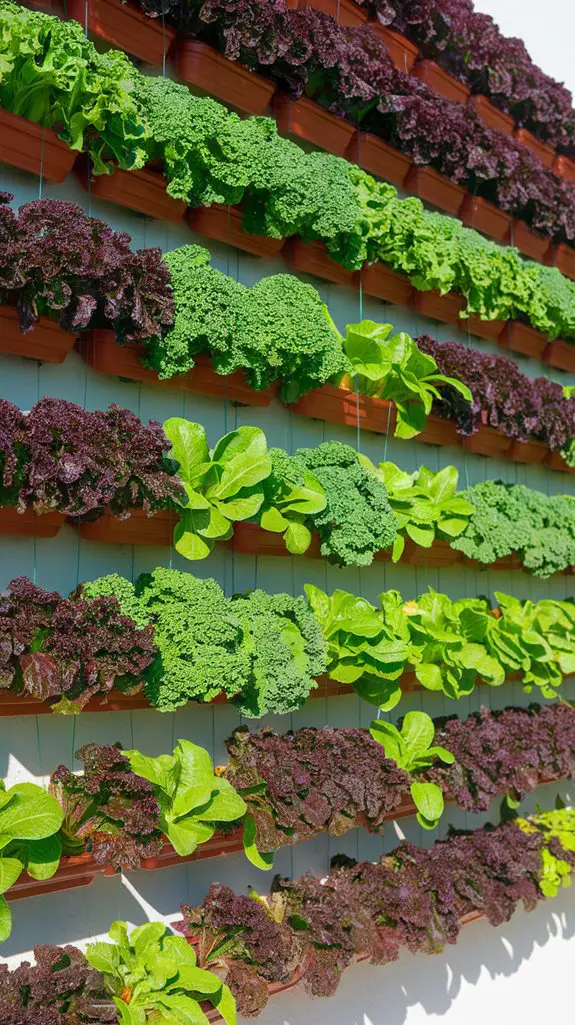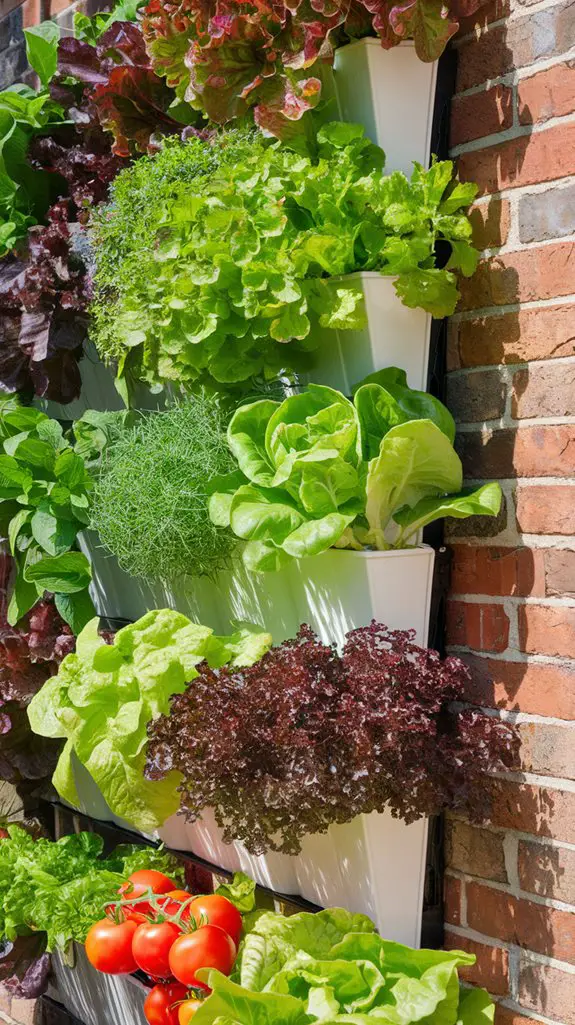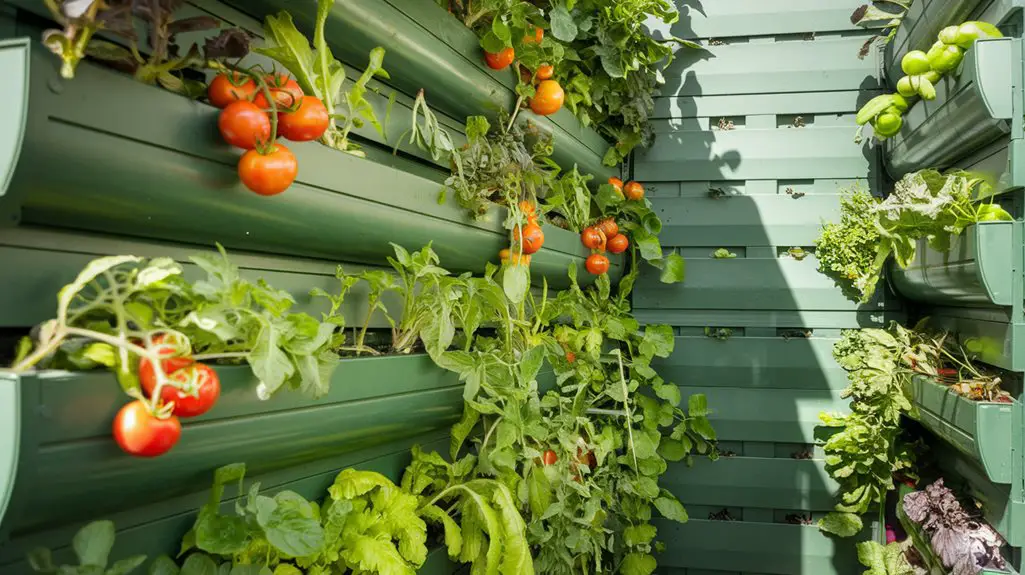If you're looking to maximize your limited gardening space, vertical gardening offers a practical solution. By employing structures like trellises, you can cultivate more plants in smaller areas, allowing for better airflow and sunlight exposure. This method not only promotes healthier crops but also minimizes the risk of pests and diseases. However, the benefits extend beyond mere space-saving. You might find that vertical gardening also enhances the overall aesthetic of your garden. What else can it do for your gardening experience?
Maximizing Space in Small Areas
When you're working with limited space, maximizing your vertical gardening setup becomes essential for thriving vegetable growth.
Start by selecting the right structures, such as trellises, shelves, or wall-mounted planters, to support your plants. Use containers that allow for efficient drainage and nutrient retention, ensuring your vegetables get the necessary resources.
Choose compact, high-yield varieties tailored for vertical gardening, like cherry tomatoes or climbing beans, which can flourish in confined areas. Employ companion planting techniques to enhance productivity; certain plants can boost each other's growth when grown together. Additionally, consider implementing vertical gardening techniques to optimize sunlight exposure and airflow, which can significantly improve your harvest.
Remember to regularly monitor soil moisture and nutrient levels, adjusting as needed to maintain ideal conditions.
Enhancing Air Circulation and Sunlight Exposure
Maximizing vertical space not only involves selecting the right structures but also ensuring adequate air circulation and sunlight exposure for your plants.
When you arrange your vertical garden, consider the spacing between plants. This spacing allows air to flow freely, reducing humidity levels and promoting healthy growth. Position taller plants at the back or center to avoid shading shorter ones, enabling all plants to receive sufficient sunlight throughout the day.
Utilize reflective materials or colors on the walls to enhance light distribution, ensuring even coverage. Additionally, rotating your plants regularly can optimize their light exposure and prevent overcrowding. Incorporating budget-friendly vertical gardens can also help maximize your urban gardening efforts without breaking the bank.
Reducing Pest Infestations and Diseases

While vertical gardening offers numerous benefits, it can also create an environment conducive to pest infestations and diseases if not managed properly. You can reduce these risks through careful planning and maintenance. For instance, increasing airflow around plants helps prevent fungal diseases. Additionally, using companion planting techniques can deter pests naturally. Implementing effective pest control methods, such as natural predators, can also enhance your garden's health.
Here's a quick reference table for effective pest management strategies:
| Strategy | Description |
|---|---|
| Crop Rotation | Prevents soil nutrient depletion |
| Natural Predators | Introduces beneficial insects |
| Neem Oil Applications | Acts as a natural pesticide |
| Regular Monitoring | Early detection of pests and diseases |
| Healthy Soil Practices | Enhances plant resilience |
Implementing these strategies in your vertical garden can greatly lower the chances of infestations and diseases.
Improving Accessibility for Harvesting
Effective pest management not only enhances plant health but also sets the stage for easier harvesting in vertical gardens. By elevating your plants, you minimize bending and stretching, making it simpler to reach your crops.
Vertical setups allow you to organize your vegetables in tiers, so you can quickly identify ripe produce without sifting through leaves or soil. This arrangement also guarantees that each plant receives adequate sunlight and airflow, promoting uniform growth and ripening.
In addition, using mobile systems, like rolling racks or hanging planters, enhances accessibility, enabling you to harvest efficiently. By prioritizing accessibility in your design, you streamline the harvesting process, saving time and reducing physical strain while maximizing your yield. Moreover, vertical garden designs can creatively utilize wall space, making the most of even the smallest areas for planting.
Promoting Aesthetics in Your Garden

To create a visually appealing vertical garden, you'll want to contemplate the arrangement and selection of your plants carefully. Consider using a mix of colors, shapes, and textures to enhance visual interest.
Taller plants should sit at the back, while shorter ones can grace the front, ensuring each plant remains visible. Incorporating trailing varieties can create a cascading effect, adding depth.
Additionally, grouping plants with complementary hues can create a harmonious look, while contrasting colors can make certain elements pop. You might also explore different planting containers with varying materials and heights, which can add dimension to your garden. Moreover, vertical garden solutions are an excellent way to maximize space and grow a variety of vegetables in a compact area.
Encouraging Diverse Plant Growth and Companion Planting
When you embrace diverse plant growth in your vertical garden, you not only enhance biodiversity but also optimize your garden's productivity. By incorporating companion planting techniques, you can create a symbiotic environment where different species support each other's growth. For instance, planting tomatoes alongside basil can improve flavor and deter pests. Vertical gardening allows you to maximize space while promoting these beneficial relationships. Additionally, varying plant heights and growth patterns can reduce competition for light and nutrients, leading to healthier plants. Incorporating a mix of flowering plants can attract pollinators, further boosting your garden's productivity. Furthermore, vertical garden systems can help you efficiently utilize limited space, making it an ideal choice for urban gardening. Ultimately, a diverse vertical garden creates a balanced ecosystem, ensuring your vegetable growth thrives efficiently and sustainably.
Conclusion
Incorporating vertical gardening into your vegetable growth strategy isn't just smart; it's revolutionary! You'll transform even the tiniest balcony into a lush, thriving Eden that rivals the Amazon rainforest! With improved airflow, sunlight exposure, and reduced pest issues, your plants will practically flourish overnight. Harvesting becomes a breeze, and your garden will be the envy of the neighborhood. So why wait? Elevate your gardening game and watch your yields soar to astronomical heights!




